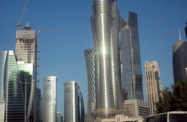It has been two years since three Gulf countries and Egypt placed an economic blockade on Qatar, to which Qatar responded by implementing a series of reforms, seeking out new trade partners and amplifying economic diversification efforts. How effective have these measures proved?

On June 5, 2017 Saudi Arabia, the UAE, Egypt and Bahrain announced the implementation of an air, sea and land blockade of Qatar. This came after they accused the government of supporting terrorism in the region, a claim that Qatar has refuted.
Given that prior to the blockade some 60% of Qatari trade moved through either Saudi Arabia or the UAE, officials at once began implementing measures to protect the economy from disruption.
See also: The Report – Qatar 2019
Building new connections
An immediate effect was the re-orientation of Qatar’s trade away from its Gulf neighbours.
Data from the OECD showed imports to Qatar fell by some 40% immediately after the announcement of the blockade, as the sanctions cut off the country’s main trade routes.
Iran and Turkey offered assistance by delivering various consumer products by ship and plane, while Iran also opened its airspace to commercial flights headed to Qatar, offsetting the closure of connections with the blockading countries.
The trend has continued over the past two years, with Qatar shifting its trade relationships towards new partners.
According to data from the Ministry of Development Planning and Statistics, business with the GCC dropped from 11.1% of overall trade in the first half of 2017 to just 3.9% in the corresponding period of 2018. Meanwhile, trade with Asia – led by Japan, South Korea and China, in addition to Turkey – increased from 61% to 69.5% of the total over the same period.
This realignment has been supported by the partial opening of the $7.4bn Hamad Port in September 2017. The port will have an annual capacity of 7.5m twenty-foot equivalent units once fully operational next year, facilitating a significant expansion in trade capacity.
The blockade has also fuelled greater self-sufficiency in sectors such as agriculture.
Since 2017 Qatar has imported thousands of cows and chickens, rapidly expanding domestic agricultural capacity. The country now produces all of its own dairy and fresh poultry, whereas in 2017 domestic production of each stood at only 20% and 10%, respectively. In 2019 the country even began exporting milk to Afghanistan, Oman and Yemen.
Reforms boost international investment
The past two years have also seen Qatar implement a series of reforms aimed at stimulating foreign direct investment (FDI).
At the start of 2019 the government enacted a law allowing foreign nationals to own 100% of shares in Qatari businesses across almost all sectors. This followed the Qatar Financial Centre’s unveiling in August last year of a five-year, $2bn incentive programme designed to bring in international firms.
Complementing these measures is the launch of Qatar’s inaugural special economic zones (SEZs). Both the 34-sq-km Um Al Houl SEZ, located next to Hamad Port, and the 4-sq-km Ras Bufontas site, next to Hamad International Airport in Doha, are expected to open in the second half of this year.
The first will focus on maritime industries, petrochemicals, building materials and logistics, while the second is expected to feature investment opportunities for companies operating in aerospace and advanced technologies.
These developments come in the context of a sharp drop in inbound FDI.
While net FDI inflows rose 31.3% to $986m in 2017, last year saw $2.2bn in net outflows, according to the UN Conference on Trade and Development’s “World Investment Report 2019”, reflecting increased caution among international investors.
Real estate and retail impacted
The real estate and retail sectors, in particular, have felt the impact of a drop-off in trade with Gulf neighbours.
Residential and office prices have fallen by about 10% since mid-2017, while rents are down 20%. Extra supply that will enter the market in the lead-up to the 2022 FIFA World Cup is expected to exert further downward pressure on prices.
Retail has also suffered as a result of the decrease in Saudi and Emirati visitors, while the doubling of retail space since 2015 to 1.4m sq metres has led to concerns of oversupply.
Weathering the storm
However, despite facing these significant challenges, the broader Qatari economy has continued to grow.
GDP expanded by 1.6% in 2017 and 2.2% last year, according to the IMF, with the economy forecast to expand by 2.6% in 2019, well above the 0.3% average predicted for the Middle East.
“Qatar’s economy has successfully absorbed the shocks from the 2014-16 drop in hydrocarbon[s] prices and the 2017 diplomatic rift,” the IMF said in a statement on June 3.
Increased natural gas production, major infrastructure investment and the use of significant financial reserves from the country’s sovereign wealth fund have all been highlighted as contributing factors to the stabilisation of the economy.
Economic optimism is similarly visible among members of the local business community. Some 84% of the CEOs surveyed in the February 2019 edition of the Oxford Business Group: Qatar Business Barometer were either positive or very positive about local business conditions in the year ahead. This sentiment was expressed by local and foreign executives alike: just under half (43%) of respondents were heads of non-local companies, of which 85% had positive or very positive views.


